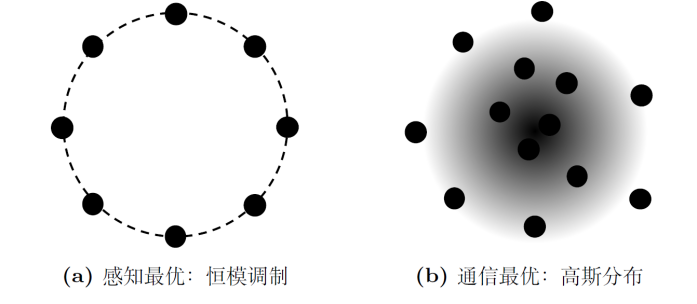Wireless sensing has been widely recognized by the communication industry as a native capability in next-generation wireless networks. Integrated Sensing and Communications (ISAC) integrates communications and sensing functions in the same wireless system, which can improve resource utilization, reduce the cost of infrastructure, and enhance the performance of both communication and sensing. ISAC technology has received great attention from both academia and industry, with related research and standardization efforts progressing rapidly. The 3rd Generation Partnership Project (3GPP) has set up research projects on ISAC in its R19, and the International Telecommunication Union (ITU) has listed ISAC as one of the six key usage scenarios for 6G.
Communications and sensing (C&S) systems adopt two types of performance evaluation frameworks, respectively. In an ISAC system, due to the shared use of wireless resources and hardware platforms between C&S subsystems, the ISAC system needs to accomplish the two major tasks of communications information transmission and target information sensing at the same time, under the constraints of time, frequency, power, and other resources. To this end, the sensing accuracy, detection probability and communication rate, bit error rate, and other performance measures are often mutually constrained by each other. Consequently, the ISAC system cannot simultaneously achieve the optimal C&S performance, leading to an inevitable performance trade-off between them.
In order to reveal the trade-off mechanism, the core idea is to study the information-theoretic limits of C&S subsystems, define the performance metrics of C&S, and characterize their achievable areas and performance boundaries. This problem remains a long-standing issue in the field of ISAC, which has no clear conclusion in the academic community.

Based on the information theory, parameter estimation, and hypothesis testing theories, the research team of Assistant Professors Fan Liu and Weijie Yuan from the School of System Design and Intelligent Manufacturing at the Southern University of Science and Technology (SUSTech), in collaboration with research teams from Beijing University of Posts and Telecommunications (BUPT), University of Electronic Science and Technology of China (UESTC), Beijing Institute of Technology (BIT), amongst others, have published a paper arguing that the C&S performance limits and achievable performance regions are the essential theories for the study of ISAC technologies.
Existing contributions are investigated from four aspects, including capacity-distortion theory, C&S performance boundary theory based on mean square error (MSE), C&S performance boundary theory based on equivalent sensing rate, and target-detection-oriented C&S performance boundary theory. Moreover, it is indicated that the C&S trade-off is two-fold, comprising the deterministic-random and subspace trade-offs. As a step further, the researchers discussed the ISAC performance limits based on practical 5G NR frame structures.
Their review paper, entitled “Information-Theoretic Limits of Integrated Sensing and Communications”, has been published in Science China Information Sciences (SCIS) and selected as the cover paper.

SCIS is a top Chinese journal in the area of electronic and information engineering, cosponsored by the Chinese Academy of Sciences (CAS) and the National Natural Science Foundation of China (NSFC). It is committed to publishing high-quality, original results of both basic and applied research in all areas of information sciences, including computer science and technology, control science and engineering, information and communication engineering, microelectronics, and solid-state electronics.

Figure 1. Six key usage scenarios in ITU’s 6G vision
By summarizing the existing performance boundary theories, Professors Liu and Yuan and their collaborators concluded that the performance trade-off between C&S is two-fold, namely, deterministic-random and subspace trade-offs.
Deterministic-Random Trade-off (DRT): Intuitively, to improve the communication rate, it is necessary to make the transmitted signals as random as possible in order to carry more information; whereas, if the sensing functionality is considered, it is necessary to transmit deterministic signals to ensure that the sensing performance is stable. The analysis in this paper points out that to achieve the best sensing performance, the deterministic characteristic of the signal causes a loss of communication degrees of freedom (DoFs). On the other hand, transmitting Gaussian signals for optimal communications performance also causes loss of sensing DoFs.
A typical example is the scalar channel case, where the transmitted signal needs to have a constant amplitude to reach the optimal sensing performance, while the empirical distribution of the transmitted signal needs to converge to a Gaussian distribution if the maximum communication rate is to be achieved. The transmit constellation for the two scenarios are shown below. It can be seen that the optimal sensing signal loses the DoF of amplitude, and thus is less capable of carrying information. At the same time, the constant-modulus characteristic of the signal allows the signal to have constant sensing performance in each random realization. In contrast, when the signal follows the Gaussian distribution, its sensing performance begins to fluctuate and is not as good as its constant-modulus counterpart in the average sense.

Figure 2. Constellations of optimal sensing and optimal communications signals in the scalar channel case
Subspace Trade-off (ST): The analysis in this paper shows that the column space of the sensing-optimal signal is aligned with the sensing channel, while the column space of the communication-optimal signal is aligned with the communications channel. This implies that when the design goal of an ISAC system is to optimize neither the communication nor the sensing performance, but to achieve a balance between them, the signal power may be appropriately allocated between the communications subspace and the sensing subspace. The degree of significance of the subspace trade-off is closely related to the strength of the coupling between the C&S channels.
Intuitively, when the communication user is the sensing target, the sensing subspace is identical to the communications subspace. In this case, there is no subspace trade-off, and the performance trade-off is solely determined by the deterministic-random trade-off. Consider another extreme where the C&S subspaces are orthogonal to each other. It is then possible to transmit the communication-optimal codebook in the communication subspace and the sensing-optimal codebook in the sensing subspace, which shows that there is no deterministic-random trade-off at this point.

Figure 3. The degree of coupling between communications and sensing subspaces determines subspace trade-offs
Associate Professor Yifeng Xiong from BUPT and a visiting scholar at SUSTech is the first author of this paper. Assistant Professor Fan Liu is the second and corresponding author, and Assistant Professor Weijie Yuan is the third author. Research Assistant Professor Yuanhao Cui from SUSTech is the fourth author, while BUPT and SUSTech are the first and corresponding affiliations of the paper, respectively.
This work was supported by the NSFC, National Key Research and Development Program, China Association for Science and Technology Young Talent Support Program, Pearl River Talent Recruitment Program of Guangdong Province, and the Shenzhen Science and Technology Program.
Paper link: https://www.sciengine.com/SSI/doi/10.1360/SSI-2023-0056
To read all stories about SUSTech science, subscribe to the monthly SUSTech Newsletter.
Proofread ByAdrian Cremin, Yingying XIA, Fan LIU
Photo BySchool of System Design and Intelligent Manufacturing